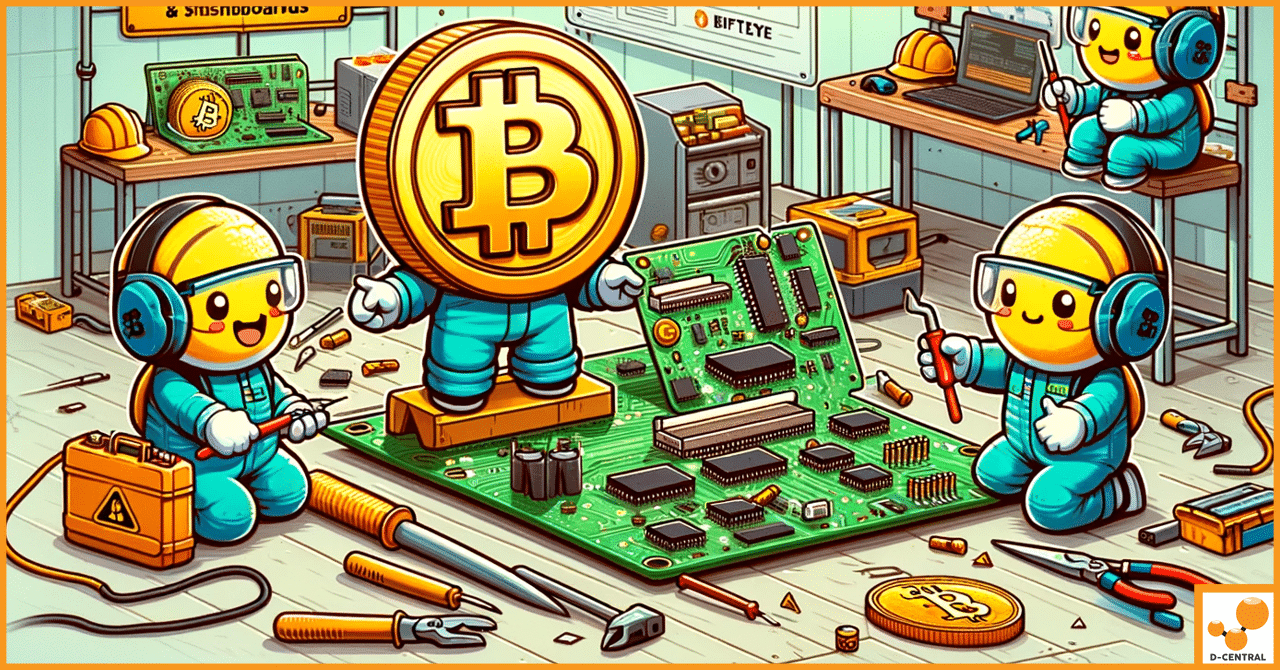
Understanding the Power of Dollar-Cost Averaging in Bitcoin
In the ever-evolving landscape of digital finance, Bitcoin has emerged as a cornerstone, redefining the essence of what we perceive
4479 Desserte Nord Autoroute 440, Laval, QC H7P 6E2

In the intricate world of cryptocurrency mining, the efficiency and longevity of mining hardware are paramount to success. At the heart of this hardware lies a critical component known as the hashboard. Hashboards, integral to the operation of Application-Specific Integrated Circuit (ASIC) miners, are densely packed with ASIC chips designed to perform the complex calculations required for mining cryptocurrencies like Bitcoin. These boards are the workhorses of the mining process, directly influencing the efficiency, speed, and overall profitability of mining operations.
Given their central role, the proper handling and maintenance of hashboards cannot be overstated. Mishandling or neglecting the care of these components can lead to decreased mining efficiency, increased downtime, and potentially costly repairs. Recognizing the need for a resource that addresses these concerns, this article aims to provide a comprehensive guide on safely handling and repairing hashboards. From basic handling precautions to advanced repair techniques, our goal is to equip cryptocurrency miners with the knowledge and tools necessary to maintain their equipment in optimal condition, ensuring maximum uptime and profitability in their mining endeavors.
Hashboards are a pivotal component in the realm of cryptocurrency mining, particularly within the structure of Application-Specific Integrated Circuit (ASIC) miners. These specialized pieces of hardware are engineered to perform one task: mining cryptocurrencies. A hashboard is essentially a printed circuit board (PCB) that houses multiple ASIC chips, which are the brains behind the mining operation. Each ASIC chip on a hashboard is designed to execute the hashing algorithms required to mine cryptocurrencies, making hashboards the core unit of mining power within an ASIC miner.
A hashboard’s primary function is to carry out the continuous, high-speed calculations needed to secure a blockchain network and, in return, earn cryptocurrency rewards. These calculations involve solving complex cryptographic puzzles through a process known as hashing. The ASIC chips on a hashboard are optimized for this specific purpose, offering unparalleled efficiency and speed compared to general-purpose hardware like CPUs or GPUs. In essence, hashboards are the battleground where the intense computational work of mining takes place, with each board contributing its hashing power to the miner’s overall capacity.
The efficiency and profitability of a cryptocurrency mining operation are directly influenced by the performance and reliability of its hashboards. Several factors underscore their significance:
In summary, hashboards are the linchpin of ASIC miners, with their design and performance playing a critical role in the efficiency and profitability of cryptocurrency mining operations. Understanding the function and importance of hashboards is essential for anyone involved in the mining industry, from hobbyists to large-scale mining farm operators.
Handling hashboards with care is paramount to maintaining the integrity and functionality of cryptocurrency mining equipment. Given their critical role and sensitivity, certain precautions must be taken to ensure these components remain in optimal condition. Here are essential guidelines for safely handling hashboards:
Hashboards, like all electronic components, are susceptible to damage from electrostatic discharge (ESD). ESD can occur when there is a sudden flow of electricity between two electrically charged objects caused by contact, an electrical short, or dielectric breakdown. The ASIC chips on hashboards are particularly vulnerable to ESD, which can degrade their performance or render them inoperative.
Using the right tools and setting up a proper workspace are crucial for safely handling and repairing hashboards.
Hashboards are not only sensitive to static electricity but also to physical shocks and vibrations, which can cause physical damage to the components.
By adhering to these precautions for handling hashboards, miners can significantly reduce the risk of damage, thereby extending the lifespan and maintaining the efficiency of their cryptocurrency mining equipment.
In the demanding environment of cryptocurrency mining, hashboards are subjected to continuous, intense operation. This relentless activity can lead to various common issues, impacting the efficiency and profitability of mining operations. Understanding these problems is crucial for timely diagnosis and repair, ensuring minimal downtime and maintaining optimal mining performance.
One of the most prevalent issues with hashboards is overheating. This condition can arise from inadequate cooling, high ambient temperatures, or excessive dust accumulation blocking the cooling mechanisms. Overheating not only reduces the efficiency of the hashboard by causing thermal throttling but can also lead to permanent damage to the ASIC chips and other components, significantly shortening their lifespan.
ASIC chips are the heart of hashboards, performing the necessary calculations for mining. Over time, these chips can fail due to various reasons, including manufacturing defects, overheating, or physical damage. Failed chips result in a reduced hash rate, directly impacting the mining output and profitability. In some cases, a single failed chip can render an entire hashboard inoperative, depending on the design of the miner.
Hashboards communicate with the miner’s main controller board to coordinate the mining process. Connection issues, such as loose or corroded connectors, damaged cables, or faulty solder joints, can disrupt this communication. These problems can cause the hashboard to be unrecognized by the miner’s firmware or to operate intermittently, leading to unstable mining performance and reduced efficiency.
The issues outlined above can have significant repercussions for mining operations, affecting both efficiency and profitability:
Proactively addressing common hashboard issues is essential for maintaining the health and efficiency of mining rigs. Regular maintenance, adequate cooling, and timely repairs can mitigate these problems, ensuring sustained mining performance and profitability.
Effective troubleshooting and maintenance of hashboards require a combination of specialized diagnostic tools and proven techniques. These tools and methods enable miners to identify and address common issues, ensuring their mining operations continue to run smoothly and efficiently. Here, we introduce essential diagnostic tools and outline basic techniques for pinpointing hashboard problems.
By employing these diagnostic tools and techniques, miners can effectively identify and address common issues with hashboards, minimizing downtime and maintaining optimal mining performance. Regular diagnostics not only help in troubleshooting but also in preventive maintenance, extending the lifespan of mining equipment and ensuring sustained profitability.
Maintaining and repairing hashboards is crucial for the longevity and efficiency of cryptocurrency mining operations. From basic upkeep to more complex component replacements, each repair task must be approached with precision and care to avoid further damage. Below, we delve into both basic and advanced repair strategies for hashboards.
Cleaning and Maintenance Tips:
Replacing Simple Components (e.g., Fans, Heat Sinks):
Step-by-Step Guide on Chip and Capacitor Replacement:
Soldering Tips and Techniques for Secure Connections:
By adhering to these guidelines for safely repairing hashboards, miners can address both basic and advanced issues, ensuring their mining hardware remains in top condition. Whether performing routine maintenance or undertaking complex component replacements, the key to successful repairs lies in meticulous attention to detail and adherence to best practices.
While many hashboard issues can be addressed through basic maintenance or advanced DIY repairs, certain situations necessitate the expertise of professional repair services. Understanding when to seek professional help and recognizing the benefits of using authorized repair centers can ensure the longevity and efficiency of your mining equipment while preserving its warranty.
In summary, while the DIY approach to hashboard repairs can be effective for minor issues, the complexity of modern ASIC miners and the potential risks associated with improper repairs make professional repair services an invaluable resource. By leveraging the expertise, tools, and genuine parts available through authorized repair centers, miners can ensure their equipment receives the best possible care, preserving its efficiency, warranty, and operational lifespan.
Ensuring the longevity and efficiency of hashboards in cryptocurrency mining operations involves more than just reactive repairs. Proactive preventative measures and adherence to best practices can significantly reduce the likelihood of hardware failures. Here’s a comprehensive guide to maintaining your hashboards in top condition.
By following these preventative measures and best practices, miners can significantly extend the lifespan of their hashboards and minimize downtime due to hardware failures. Regular maintenance, environmental control, and staying up-to-date with firmware are key strategies for maximizing the profitability and sustainability of cryptocurrency mining operations.
The meticulous handling and repair of hashboards are foundational to the success and sustainability of cryptocurrency mining operations. As we’ve explored, hashboards are the heart of ASIC miners, performing the critical computations that drive the mining process. Their well-being directly influences the efficiency, profitability, and longevity of mining hardware. Recognizing the potential challenges—from overheating and component failures to firmware vulnerabilities—it’s clear that proactive maintenance and skilled repairs are not just beneficial but essential.
We’ve covered the spectrum of care for hashboards, from basic cleaning and maintenance routines to the complexities of advanced repairs. The importance of using the right tools, creating a conducive environment, and staying informed about the latest firmware updates cannot be overstated. These practices ensure that your mining operations run smoothly, securely, and profitably.
However, the journey doesn’t end here. The field of cryptocurrency mining is ever-evolving, with new challenges and solutions emerging regularly. Sharing knowledge and experiences within the mining community can lead to innovative practices and troubleshooting techniques. Therefore, we encourage you to engage with fellow miners, whether by commenting below with your insights or by participating in online forums and discussions.
For those looking to delve deeper or require professional assistance, numerous resources are available. Here are some links to recommended tools, parts suppliers, and professional repair services that can help you maintain your mining equipment in peak condition.
By adhering to the best practices outlined in this guide and leveraging the collective wisdom of the mining community, you can navigate the complexities of hashboard maintenance and repair. This not only ensures the operational efficiency of your mining rigs but also contributes to the broader success and advancement of the cryptocurrency mining industry.
What are hashboards in cryptocurrency mining?
Hashboards are critical components in ASIC miners, containing multiple ASIC chips designed to perform the complex calculations required for mining cryptocurrencies like Bitcoin. They play a pivotal role in determining the efficiency, speed, and overall profitability of mining operations.
Why is proper handling and maintenance of hashboards important?
Proper handling and maintenance of hashboards are crucial to prevent decreased mining efficiency, increased downtime, potential costly repairs, and to ensure maximum uptime and profitability in mining endeavors.
What basic precautions should be taken when handling hashboards?
When handling hashboards, it’s essential to implement anti-static measures, such as wearing an anti-static wrist strap and working on an anti-static mat. It’s also important to use non-magnetic tools, maintain an organized and adequately lit workspace, and handle hashboards gently to avoid physical damage.
What are some common issues faced by hashboards?
Common issues include overheating, failed ASIC chips, and connection problems, all of which can significantly impact mining efficiency and profitability. Overheating can render chips inoperative, failed chips reduce the hash rate, and connection issues can cause intermittent or complete loss of communication with the hashboard.
How can I diagnose hashboard issues?
Diagnosis can involve the use of multimeters, STASIC Tech Hashboard MultiTester, and thermal cameras to check electrical properties, analyze operational status, and identify hot spots. Visual inspection and connectivity checks are also key techniques for diagnosing issues.
What steps can be taken to repair hashboards safely?
Safely repairing hashboards involves both basic and advanced strategies, from cleaning and simple component replacements to more complex tasks like chip and capacitor replacement. It’s crucial to use the correct tools, practice precise soldering techniques, and follow safety protocols to avoid further damage.
When should professional repair services be utilized for hashboards?
Professional repair services should be considered for complex component failures, recurring issues, warranty preservation, or if there’s a lack of tools or expertise for DIY repairs. Authorized repair centers offer expertise, genuine parts, advanced tools, and sometimes a warranty on repairs.
What preventative measures and best practices can extend the lifespan of hashboards?
Implementing a routine maintenance schedule, keeping firmware updated for performance improvements and security, controlling environmental factors like temperature and humidity, and ensuring adequate airflow and cooling are key to prolonging hashboard longevity and maintaining mining efficiency.
DISCLAIMER: D-Central Technologies and its associated content, including this blog, do not serve as financial advisors or official investment advisors. The insights and opinions shared here or by any guests featured in our content are provided purely for informational and educational purposes. Such communications should not be interpreted as financial, investment, legal, tax, or any form of specific advice. We are committed to advancing the knowledge and understanding of Bitcoin and its potential impact on society. However, we urge our community to proceed with caution and informed judgment in all related endeavors.
Related Posts

In the ever-evolving landscape of digital finance, Bitcoin has emerged as a cornerstone, redefining the essence of what we perceive

In the dynamic world of cryptocurrency, Bitcoin mining stands as a cornerstone activity, pivotal to the maintenance and expansion of

In recent years, the global economic landscape has undergone significant transformations, marked by fluctuating markets, uncertain monetary policies, and a